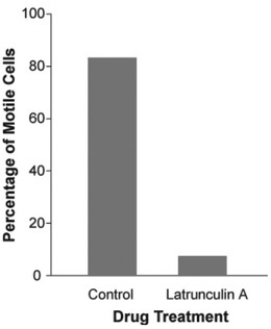Multiple Choice
Use the following information to answer the question(s) below.
The mechanism of cell crawling in protist species is not well defined. Pseudopodia extension involves interactions between actin and myosin (the same molecules that are involved in vertebrate muscle contraction) . However, prior to the study described below, no one had provided convincing data that actin and myosin were actually involved in cell crawling in protists. Anatomical studies had identified the cytoskeletal protein actin just below the surface of the cell membrane in several species of protist, but physiological studies had failed to show a functional link between actin, myosin, and cell crawling.
In a study by N. Poulsen et al. (Diatom gliding is the result of an actin-myosin motility system, Cell Motility and the Cytoskeleton 44 (1999) :23-22) , researchers tested whether motility in a particular species of diatom involves interactions between actin and myosin. 
-Refer to the study by Poulsen et al. and the accompanying figure. Cultures of a species of diatom were treated with BDM, a reversible inhibitor of myosin function. Which of the following predictions is consistent with the hypothesis that an actin-myosin interaction is necessary for motility?
A) BDM will significantly decrease motility of the cells in culture.
B) BDM will not significantly alter motility of the cells in culture.
C) BDM will significantly increase motility of the cells in culture.
Correct Answer:

Verified
Correct Answer:
Verified
Q11: All protists _.<br>A) contain a nucleus<br>B) are
Q12: Use the following information to answer the
Q13: Which of the following was derived from
Q14: Alternation of generations occurs in some protists.
Q15: Assume that some members of an aquatic
Q17: You are given an unknown organism to
Q18: The microsporidian Brachiola gambiae parasitizes the mosquito
Q19: According to the endosymbiosis theory of the
Q20: Dinoflagellates _.<br>A) have a glass-like cell wall<br>B)
Q21: One of the fish in your aquarium